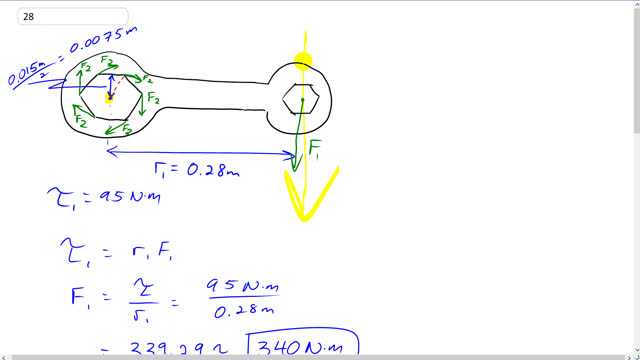
The bolts on the cylinder head of an engine require tightening to a torque of . If a wrench is 28 cm long, what force perpendicular to the wrench must the mechanic exert at its end? If the six-sided bolt head is 15 mm across (Fig. 8–44), estimate the force applied near each of the six points by a wrench.


In order to watch this solution you need to have a subscription.
This is Giancoli Answers with Mr. Dychko. We are going to calculate two difference forces here: the first force to calculate is the one applied by the person's hand on the end of the wrench here that's F 1 that's directed straight down and it's perpendicular to this lever arm r 1 the distance from the pivot to the point where this force is applied. So knowing that this torque has to be 95 newton meters, according to the specifications of this cylinder head, we can calculate the force by dividing both sides by r 1 here in this torque equals lever arm times time formula. No angles involved here because the angle is 90 degrees so sin of that angle is just 1, sin 90 is 1. So we have F 1 is torque divided by lever arm—95 newton meters divided by 0.28 meters which gives about 340 newton meters. So that was the easy part and the slightly harder part is to calculate each of these six forces here that are between the wrench corner and this corner of the bolt head. So we'll assume that each of these forces are perpendicular to the lever arm connecting the point of the bolt to the center of the bolt and we need to figure out what this length is then knowing that this length shown in blue here is half of 15 millimeters or half of 0.015 meters which is 0.0075 meters and here's another perspective on that picture. So 0.0075 meters is from the center of the bolt to this center of this flat edge there and we need to figure out the distance from the center to this corner which is where we assume the force is being applied perpendicular to I guess like this shown in my picture up here. So well this is 30 degrees in there and the reason for that is because if you think of cutting this bolt head into all these sectors there's one, two, three, four, five, six equal size sectors here because the bolt is all symmetrical so they are all gonna be equal and that's a total of 360 degrees that's cut six ways and then we are cutting that in half with this dotted line and so 360 divided by 6 divided by 2 or 360 divided by 12 in other words is 30 so that's where this 30 degrees comes from. So 30 degrees is 360 degrees in a full circle divided by 12 so six sectors connecting each of the corners to the center and then knowing that this dotted line divides one of the sectors in half. Okay. So cos of 30 is gonna be the adjacent which is 0.0075 meters divided by this lever arm r 2 that we are trying to find divided by this hypotenuse in other words in this right triangle here. So we solve for r 2 by, you know, multiplying both sides by r 2 and then dividing both sides by cos 30 and we get r 2 is 0.0075 meters over cos 30 which is 0.00866 meters. Now the total torque exerted by all of these forces combined has to equal the torque resulting from this single force here and so that's what we say here and that means torque two is going to be 6 times the torque due to each of the forces and there are 6 of them so that's why we multiply the total or we multiply each torque due to each of these forces by 6 since there are 6 corners. So we'll find each of the forces by dividing both sides by 6r 2, switch the sides around and we get the force F 2 is gonna be the torque 95 newton meters divided by 6 times 0.00866 meters which gives about 1800 newtons. 1800 newtons is one of the forces applied at one of the corners of the bolt.